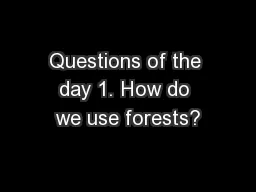

2 From yesterdays video how has the technology changed with forestry What has been the impact of these technological changes Goodbad explain Quick HW pg 49 Review History of Forests A Indiscriminant cutting ID: 651703
Download Presentation The PPT/PDF document "Questions of the day 1. How do we use fo..." is the property of its rightful owner. Permission is granted to download and print the materials on this web site for personal, non-commercial use only, and to display it on your personal computer provided you do not modify the materials and that you retain all copyright notices contained in the materials. By downloading content from our website, you accept the terms of this agreement.
Slide1
Questions of the day
1. How do we use forests?
2. From yesterday’s video, how has the technology changed with forestry?
What has been the impact of these technological changes? Good/bad explain.Slide2
Quick HW pg. 49 ReviewSlide3
History of ForestsSlide4
A. Indiscriminant cutting
Oak and Pine cut for shipbuilding and housing
Land cleared for agriculture to grow food. First in the Northeast, then Midwest, then the South, lastly the Pacific Northwest (which is predominantly Douglas Firs) Slide5
Originally about
50%
of the country was forested (900 million acres)
Now about 33% or 1/3 of the land is forested
Timber harvested furnishes us with about 4500 different types of products- Large part of the economySlide6
Clear Cut ForestSlide7
Players in the conservation movement
In the late 1800’s, concern for forest conservation begins due to large swaths of forested land in US being cut and wild lands being lost
Conservationist- Teddy Roosevelt and Gifford Pinchot
Preservationists- John MuirSlide8
National Forest Service
Begins 1905
Started by Teddy Roosevelt
Headed up and organized by Gifford Pinchot (also, a two time governor in PA)Slide9
Teddy Roosevelt and
John Muir
http://www.pbs.org/nationalparks/watch-video/#645Slide10
Teddy Roosevelt
and Gifford Pinchot
Read Inquirer Article
Answer these questions:
1.Why was Roosevelt interested in conservation?
2. By the end of Roosevelt’s term, how many National Forests were there?
3. Roosevelt and Pinchot’s views of natural resources differed from those of John Muir. What are the terms associated with their views, and how do they differ?
4. Would you consider yourself a preservationist or a conservationist?Slide11
How are forests used?
Multiple use management- Forests are managed to provided multiple benefits to wildlife and people.
There are six important benefits:Slide12
1. Timber production
Timber harvest for wood products
Today use sustainable harvesting methodsSlide13
2. Watershed protection
Trees prevent erosion and the build up of silt in the water- this is called a riparian buffer.
Raindrops are broken by leaves, and fall gently onto the “duff” (litter of composting leaves and twigs) instead of running off the surface.Slide14
Slide15
2. Watershed Protection cont’d
Water soaks into channels made by roots and animals to replenish ground water.
Trees prevent floods when there is very hard rain.
Johnstown, PA flood 1889
http://www.jaha.org/FloodMuseum/history.htmlSlide16
3. Climate Protection
Water evaporating from leaves keeps air cool and moist. (Think of how it feels when you enter a forest in the summertime.)
Rows of trees (shelter belt) along a farm field, slows down wind and prevents soil erosion.Slide17
Shelter Belt exampleSlide18
3. Climate protection cont’d
Trees remove microscopic dust particles and some toxic pollutants from the air and soil.
Trees remove CO
2
(gas which causes global warming). Trees can take in 26lbs of CO
2
and convert it to sugars and oxygen.Slide19
4. Grazing
Farm woodlots are place for cattle, sheep and pigs to “forage.”(find food on the forest floor) Pigs that feed on chestnuts/apples taste better.
Must be careful not to allow overgrazing, or all plant cover will be removed and the soil will become compacted.Slide20
Sheep grazing in Apache National Forest, AZSlide21
5. Recreation
Forests are enjoyed by hikers, bikers, campers, birdwatchers etc.
Forest are spiritually refreshing to many.
National Forest nearby include:
Alleghney
Nat’l Forest, Finger Lakes Nat’l Forest
http://www.fs.fed.us/r9/forests/allegheny/
http://www.fs.fed.us/r9/forests/greenmountain/htm/fingerlakes/f_home.htmSlide22
6. Wildlife Protection
Forests provide food, shelter and water for wildlife.
Foresters can help by making some sunnier clearings where weeds, shrubs, vines, grasses can produce
seeds, nuts, berries for food
(we call this
mast
)
Snags
(dead tall standing trees)
and old logs serve as dens, nests and
nurse logs (logs in the process of decomposing)Slide23
Nurse log ecosystemSlide24
Pileated
Woodpeckers
and Snags in Forests
http://
www.youtube.com/watch?v=SpYsdZ8gUU8
Textbook : Read pages 57-60
. Complete
questions
2-10
for
HW.Slide25
6. Wildlife Protection
Healthy forests provide for cleaner, coolers stream water for fish, like trout.
The more birds and bats there are the fewer insects there are.
In our area, deer have become overabundant, which has impacted our forests. (Think Valley Forge)Slide26
Types of Trees and Forests